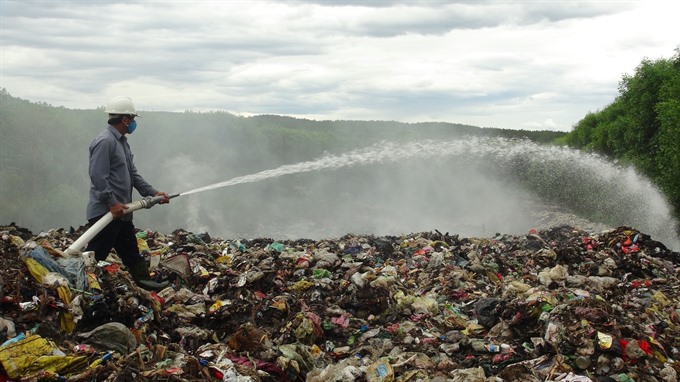

As Việt Nam’s wealth and population have increased, so, too, has something altogether less pleasant: the amount of the country’s waste.
 |
| An employee of the environment service agency of Lệ Thuỷ District in the central province of Quảng Bình tries to control a fire that raged for 10 days in a landfill, causing serious smoke pollution in the area and affecting hundreds of nearby households. — VNA/VNS Photo Đức Thọ |
HÀ NỘI — As Việt Nam’s wealth and population have increased, so, too, has something altogether less pleasant: the amount of the country’s waste.
With current technology for treating and storing the waste still far behind the country’s needs, dump sites are starting to pose a threat to the environment and to public health, according to Mai Thanh Dung, vice director of the Institute of Strategy and Policy on Natural Resources and Environment (ISPONRE), in a workshop held last week on the management of waste storage sites in Việt Nam.
The most popular method of solid waste treatment is still burial, thanks to its relatively low cost, little initial investment and ability to handle most types of solid waste. However, the increasing amount of waste, lax management and disregard for technical protocols are rapidly making this method unsustainable.
According to the Ministry of Construction, the total amount of household waste generated each day in Việt Nam stands at 38,000 tonnes, with the rate of collection and treatment only reaching 85 per cent.
By 2016, there were about 600 landfills in the country – excluding small and scattered ones at the commune level – with a total area of 4,900 ha. Only 29 to 31 per cent of these landfills, or 200, are actually considered to have met required sanitary standards.
In big cities, where treatment by burial accounted for 69 per cent of all waste management, the resulting degradation of water, land, and air quality has been a growing concern.
According to a survey conducted by the Ministry of Environment and Natural Resources, in many provinces of the south-central coastal and Central Highlands regions, industrial waste and household waste are still buried together in subpar landfills. Especially in the Central Highlands, open dump sites are often located in the valleys close to headwaters, putting downstream populations at serious risk of health problems from contaminated water.
Similarly, in the Mekong Delta region, many landfills are constructed without proper embankments. In the rainy season, the pits are filled with water that can spill over and contaminate surrounding areas.
The MoNRE’s report pointed out other problems with landfill design. For example, there is a lack of planning for landfills at the local level, limited mobilisation of investment into landfill projects and the continued use of outdated technical standards in the design of new landfills.
An ISPONRE representative said that the national goal of having certified 90 per cent of landfills by 2020 is looking unlikely, based on the current situation.
Associate Professor Vũ Đình Hiếu, from the Hà Nội University of Mining and Geology, also delivered a sobering report on mine waste dumps. According to Hiếu, the waste produced by mining activities in Việt Nam – a staggering 312 to 403 million cu.m a year – is concentrated in the northeast region, where most of the country’s mineral resources are located. Mine waste dump sites might easily deform a whole area’s geological features, including rivers and forests, he said. In some cases, the size of each dump site might be as large as the actual mining site, eating up large land areas.
Numerous acute disasters can also result from these dump sites, like dust pollution, desertification, or potential soil erosion and mud floods, especially during monsoons. The country has already witnessed such floods in the cases of Phấn Mễ mine in Thái Nguyên Province (2012) or in Hòn Gai of Quảng Ninh Province.
Hiếu urged proper planning of these industrial dump sites. They must also follow environmental standards requiring the planting of 3,000 trees per hectare and the installation of an appropriate and capable drainage system and stable embankments to minimise risks of disasters, he said. — VNS




